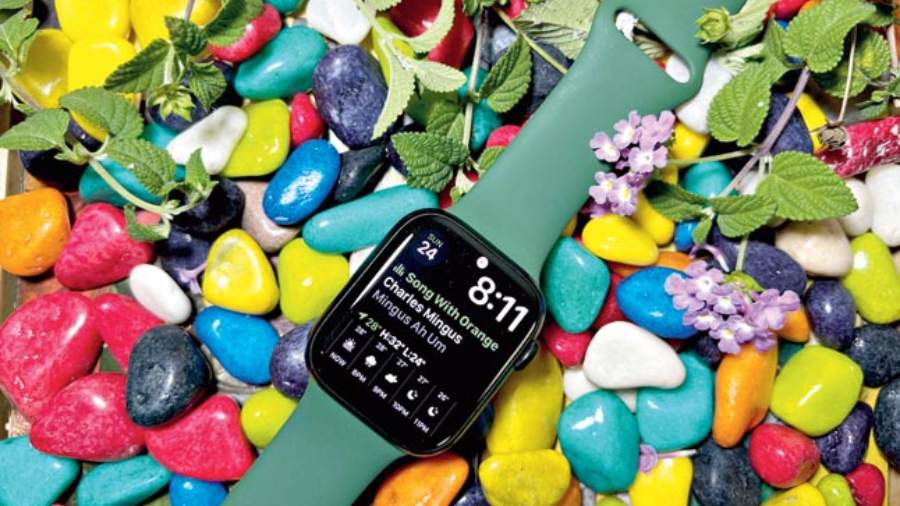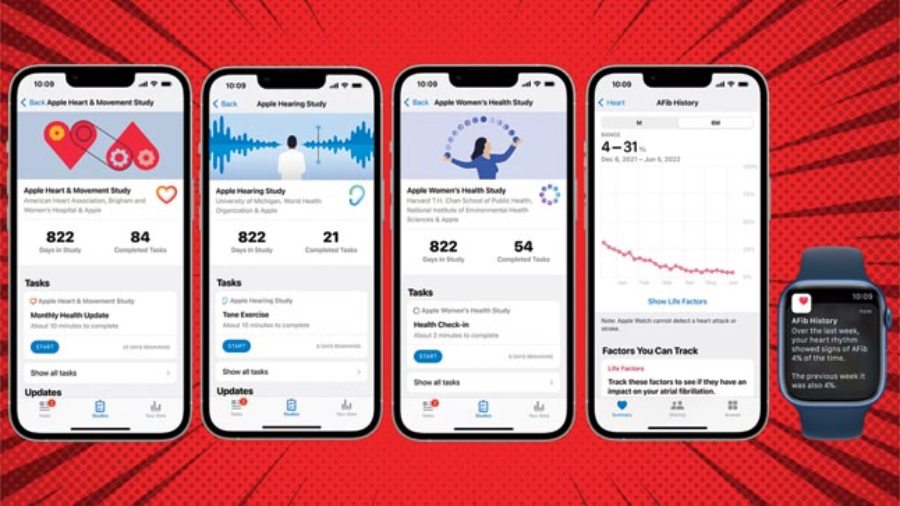In the 1860s, an aphorism that caught the imagination was “Eat an apple on going to bed and you’ll keep the doctor from earning his bread”, which decades later reappeared in the form of “an apple a day keeps the doctor away”. But in 2022, Apple is meant to be worn on the wrist and carried in the pocket as the Apple Watch and the Health app have become central to our well-being.
Be it the functions on the Watch, the metrics collated via the Health app or how health organisations are putting Apple devices to good use, there are too many things that’s happening and one may need a snapshot or an overview, which is something Apple has shared in the form of a new report.
There are two compartments into which Apple’s efforts can be divided into, one focuses on personal health and fitness features on Apple Watch and iPhone while the other involves the company’s work with the medical community to support research and care.
Personal health journey
The two landmark moments in the journey have been the release of the Health app in 2014 and the Apple Watch a year later. Since then, plenty of new fitness features have been introduced to take care of health.
The Health app is where users can keep track of all parameters in one central and — very importantly — secure place, including data from Apple Watch and iPhone, connected third-party apps and devices, and connected Health records institutions. Health app data is never shared with any party without the user’s explicit permission. Then comes the Apple Watch, which has several sensors to capture heart health, mobility, hearing health, safety, and preventative health features.
The progress made by the Health app has been nothing less than outstanding, tackling a lot of criticism and naysayers along the way. Today, users can store over 150 different types of health data from Apple Watch, iPhone, and third-party apps and devices in the Health app. Data from the many health and fitness features is available in one central view and features like Trends allow users to identify important changes over time.
The Apple Watch, on the other hand, is always on the wrist, and is known to have saved lives by making users aware of cardiovascular issues. Atrial fibrillation or AFib is a heartbeat irregularity that often goes undiagnosed and is a leading cause of stroke and hospitalisation. With the irregular rhythm notification feature, Apple Watch can occasionally check heart rhythm in the background and send a notification if an irregular heart rhythm that appears to be AFib is identified, so users can seek medical evaluation.
Equally important is the ability to notify users if the Watch detects a high heart rate when a user is at rest, which can be a sign of a serious underlying condition. It can also notify users when their heart rate is notably low for at least 10 minutes, known as bradycardia.
Another important metric surfaces, thanks to the advanced accelerometer and gyroscope in Apple Watch Series 4, 5, 6, and 7. These sensors allow the Watch to detect hard falls, using the motion sensors and an algorithm to identify if a fall occurs based on wrist trajectory and impact acceleration. The fall detection feature is paired with Emergency SOS. If a hard fall is detected and the user is immobile for about a minute, Apple Watch’s Emergency SOS feature automatically calls emergency services and notifies the emergency contacts registered in the user’s Medical ID with a text message and the user’s location. The feature is available globally and has helped people of all ages.
A breakthrough feature that arrived in 2021 was Walking Steadiness in the Health app which leverages the powerful sensors in iPhone along with custom algorithms to give users an overall sense of their fall risk in the next 12 months. The walking steadiness feature estimates balance, stability, and coordination. It uses mobility metrics like walking speed, step length, double support time, and walking asymmetry to determine a user’s walking steadiness and classification.
Supporting the health ecosystem
Innovative features need to be made available to the medical community as well as Apple needs to work with experts to ensure that the Watch and the Health app remain meaningful.
iPhone and Apple Watch give researchers the opportunity to recruit participants from a large user base, and for participants to choose to share health data they collect throughout their lives to help advance science. Here’s an example: Apple has collaborated with Harvard T.H. Chan School of Public Health, Brigham and Women’s Hospital, the University of Michigan, and others to offer users across the US the opportunity to participate in the Apple Women’s Health Study, the Apple Heart and Movement Study, and the Apple Hearing Study. Further, Apple is supporting a number of other studies, and ResearchKit makes it easier for researchers around the world to build apps for innovative studies at unprecedented scale.
ResearchKit and the Research app are designed to help researchers advance toward potentially groundbreaking advancements. Many research projects (some now completed, ongoing or starting) have been made possible by ResearchKit, including Apple’s first-of-its-kind Apple Heart Study to detect irregular heart rhythms and Mom Genes Fight Postpartum Depression at UNC to explore a genetic cause to postpartum depression.
In 2017, Apple scientists collaborated in research led by the Stanford University School of Medicine to conduct the Apple Heart Study on AFib detection. The success of the Apple Heart Study to look at a bigger picture. The company introduced the Research app to broaden the scope of what research could be done digitally by giving researchers the tools to help them uncover new insights. By downloading the Research app from the App Store, users can easily enrol in health studies from their iPhone, while maintaining control over which data types they choose to share with the study team. Users can also choose to stop contributing to any study at any point in time.

Apple Watch comes with plenty of sensors to keep tracking health metrics. Picture: The Telegraph
Overview of health and fitness features on Apple Watch and iPhone
Heart health: High/low heart rate notifications, resting, walking, and post-workout heart rate, heart rate variability, ECG app, irregular rhythm notifications, cardio fitness, cardio recovery, AFib history
Sleep: Wind down, sleep tracking, sleep stages
Respiratory: Respiratory rate during sleep, blood oxygen
Mobility: Fall detection, walking steadiness and notifications, mobility metrics like double support time, step length, six-minute walk, and more
Hearing health: Headphone audio levels and notifications, Noise app and notifications
Mindfulness: Mindfulness app, meditation in Fitness+, Focus
Handwashing: Automatic handwashing detection and reminders
Women’s health: Cycle tracking, period prediction and fertile window prediction, symptom tracking, cycle factors, workouts for pregnancy and get back to fitness after having a baby Fitness+ programmes
Medications: Set up a medications schedule and reminders, medications education and alerts for potential critical interactions











